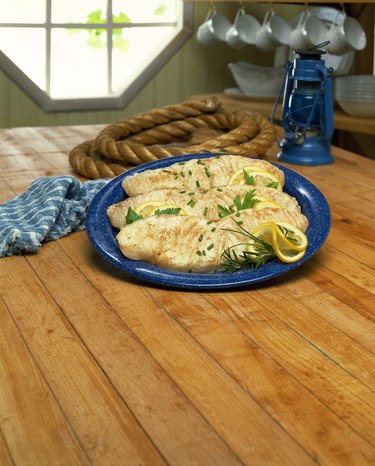
Seafood aficionados enjoy a large number of fish with firm, white flesh, but halibut is one of the finest. It's also one of the largest, with prize specimens often weighing hundreds of pounds. You seldom see a whole halibut at your local supermarket or fishmonger, because of its size, but both steaks and fillet portions are commonly available. They can be cooked similarly, but there are differences between them.
The Skinny on a Flat Fish
Video of the Day
Closely related species of halibut are harvested on both the Atlantic and the Pacific coasts, though the population of Atlantic halibut is low and tightly managed in many areas. Like other flat fish such as flounder and turbot, it yields four fillets -- two from the dark upper side and two thinner ones from the pale lower side -- rather than the symmetrical left and right fillets of conventional round fish. Smaller specimens can be cut crosswise into steaks, a less labor-intensive technique than filleting.
Video of the Day
Halibut Steaks
While fillets can come in almost any size, halibut steaks are more consistent. They typically range from 6 ounces to 1 pound or so for very large steaks, and they measure 3/4 to 1 inch in thickness. All but the largest are usually considered single portions, though two people of moderate appetite can share even a small one. A steak is always surrounded by a strip of skin, which can be eaten or removed at the diner's discretion. It contains a section of the backbone as well and may contain fragments of rib bone. Each steak is visibly divided into four sections -- corresponding to the four fillets -- and the bones are found between those sections, so they're easily avoided.
Halibut Fillets
Halibut fillets are usually cut into individual portions for retail sale, typically ranging from 4 ounces to 1/2 pound or more. On request, most fishmongers will cheerfully save you a larger piece to cook as the centerpiece of a special meal. Fillets are sold with the skin and bones removed, leaving just the firm, white flesh. The portions can be quite thick, often 2 1/2 inches or more if they're from the dark side of a moderately large fish. They take longer to cook than most fillets from other types of fish, but they're also less prone to overcooking and drying out.
Making Your Choice
There's no hard and fast rule that indicates when to buy steaks and when to buy fillets, because it's largely a matter of personal preference. Some diners like to eat the skin, and don't mind dealing with bones, so they're perfectly happy with steaks. More fastidious guests might prefer the trouble-free dining offered by a boneless fillet portion. Steaks can be grilled successfully because they're held together by their skin and bones. Fillet portions are better reserved for cooking methods such as pan-searing, baking or poaching, which aren't as rough on the portions and reduce the risk of breaking one.